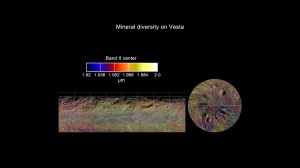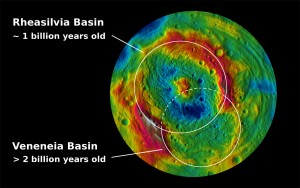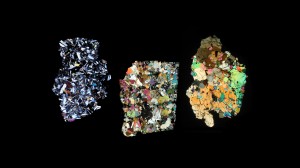NASA’s UCLA-led Dawn mission shows protoplanet’s surprising surface
When UCLA’s Christopher T. Russell looks at the images of the protoplanet Vesta produced by NASA’s Dawn mission, he talks about beauty as much as he talks about science.
“Vesta looks like a little planet. It has a beautiful surface, much more varied and diverse than we expected,” said Russell, a professor in UCLA’s Department of Earth and Space Sciences and the Dawn mission’s principal investigator. “We knew Vesta’s surface had some variation in color, but we did not expect the diversity that we see or the clarity of the colors and textures, or their distinct boundaries. We didn’t find gold on Vesta, but it is still a gold mine.”
Dawn has been orbiting Vesta and collecting data on the protoplanet’s surface since July 2011. Vesta, which is in the doughnut-shaped asteroid belt between Mars and Jupiter, is currently some 321 million miles from Earth.
The journal Science publishes six papers about Vesta on May 11. Russell is a co-author on all of them.
About the image: Global mineral map of Vesta. This colorized map from NASA’s Dawn mission shows the distribution of minerals across the surface of Vesta. It was made from spectra –- data collected in different wavelengths of radiation –- obtained by Dawn’s visible and infrared mapping spectrometer. The spectrometer data were then laid over a mosaic created by Dawn’s framing camera. The map indicates that the Vesta surface is not uniform, with a sharp contrast between the northern and southern regions. The visible and infrared mapping spectrometer detected a type of mineral known as diogenite that is typical of Vesta’s lower crust. The upper crust, however, has more eucritic material. Diogenites are silicate rocks with more magnesium than the eucrites, which are richer in iron. These data suggest that the region around the Rheasilvia basin is richer in diogenites than the equatorial regions. The north-south variation in minerals indicates that the deep crust exposed in the southern Rheasilvia region is dominated by pyroxene-rich, diogenitic material while the equatorial region seems to retain the most ancient eucrite-rich mineralogy. In this image, blue shows a richer concentration of diogenite minerals and yellow shows a richer concentration of eucrite minerals. The visible and infrared mapping spectrometer collected the data used to create this mosaic image in August 2011, from an average altitude of about 1,700 miles or (2,700 kilometers). The Dawn mission to Vesta and Ceres is managed by NASA’s Jet Propulsion Laboratory, a division of the California Institute of Technology in Pasadena, for NASA’s Science Mission Directorate, Washington. UCLA is responsible for overall Dawn mission science. The visible and infrared mapping spectrometer was provided by the Italian Space Agency and is managed by Italy’s National Institute for Astrophysics, Rome, in collaboration with Selex Galileo, where it was built.
Russell and his scientific team expected to find a large crater on Vesta, but they were surprised to find two, with the larger one essentially on top of the smaller. The smaller crater covers roughly the distance from Los Angeles to Monterey, Calif.; the larger one would stretch from L.A. to San Francisco.
“When we got to Vesta, we found two very large impacts, both in the southern region,” Russell said. “One dates at about a billion years ago, and the other at least 2 billion years ago. Seeing two was a real discovery, and getting their ages is even better. The ages look like they correspond to the dates when we think rocks were blasted off Vesta; some came all the way to Earth. The large size of the craters can easily account for the material that came off, to fall as meteorites and many smaller ‘Vestoids’ that are like very large boulders.”
Many of the so-called Vestoids are approximately one-half mile to five miles across, and there may be thousands of them throughout the asteroid belt, Russell said. Named for the ancient Roman goddess of the hearth, Vesta has been bombarded by comets, meteoroids and its smaller siblings for 4.5 billion years.
About the image: Craters on Vesta. This colorized map from NASA’s Dawn mission shows the distribution of minerals across the surface of Vesta. It was made from spectra –- data collected in different wavelengths of radiation –- obtained by Dawn’s visible and infrared mapping spectrometer. The spectrometer data were then laid over a mosaic created by Dawn’s framing camera. The map indicates that the Vesta surface is not uniform, with a sharp contrast between the northern and southern regions. The visible and infrared mapping spectrometer detected a type of mineral known as diogenite that is typical of Vesta’s lower crust. The upper crust, however, has more eucritic material. Diogenites are silicate rocks with more magnesium than the eucrites, which are richer in iron. These data suggest that the region around the Rheasilvia basin is richer in diogenites than the equatorial regions. The north-south variation in minerals indicates that the deep crust exposed in the southern Rheasilvia region is dominated by pyroxene-rich, diogenitic material while the equatorial region seems to retain the most ancient eucrite-rich mineralogy. In this image, blue shows a richer concentration of diogenite minerals and yellow shows a richer concentration of eucrite minerals. The visible and infrared mapping spectrometer collected the data used to create this mosaic image in August 2011, from an average altitude of about 1,700 miles or (2,700 kilometers). The Dawn mission to Vesta and Ceres is managed by NASA’s Jet Propulsion Laboratory, a division of the California Institute of Technology in Pasadena, for NASA’s Science Mission Directorate, Washington. UCLA is responsible for overall Dawn mission science. The visible and infrared mapping spectrometer was provided by the Italian Space Agency and is managed by Italy’s National Institute for Astrophysics, Rome, in collaboration with Selex Galileo, where it was built.
Among the other new discoveries reported in Science:
- Vesta has large mountains — the largest is more than twice the size of Mount Everest — which were formed by a major impact to the protoplanet’s surface. Scientists thought most of Vesta outside the south polar region might be flat like the moon, yet some of the craters outside that region formed on very steep slopes and have nearly vertical sides, with landslides often occurring in the regolith, the deep layer of crushed rock on the surface.
- The Dawn mission has witnessed a pattern of minerals exposed by deep gashes created by space-rock impacts to Vesta. This might support the idea that Vesta was once molten inside and had a sub-surface magma ocean.
- Vesta has an iron core, formed during the period in which the protoplanet was molten, at the earliest epoch of the solar system; Dawn’s measurements of Vesta’s gravitational field have confirmed this. This finding was expected because meteorites from Vesta have less iron than the solar nebula from which planetary building blocks formed. That the iron is indeed sequestered in Vesta’s core confirms thinking that Vesta separated into layers when it formed, and this starting composition allows scientists to constrain early solar system models.
- Vesta’s surface contains many bright spots of varying size. A real surprise is that Vesta also has some areas as dark as coal. The dark and light markings form intricate patterns suggesting the dominance of impact processes in creating mixed layers in Vesta’s regolith.
“It looks like an artist has painted the craters in fancy patterns,” Russell said. “It is beautiful, and surprising.”
Dawn has obtained more than 20,000 images of Vesta and millions of spectra, or data collected from different wavelengths of radiation.
“Everything is working,” Russell said proudly.
Studies of meteorites found on Earth that are linked to Vesta suggest that Vesta formed from interstellar gas and dust during the solar system’s first 2 to 5 million years.
“Vesta has been recording the history of the solar system from the beginning,” Russell said. “We are going back to the beginning of the solar system — more than 4.5 billion years ago. We’re going back further than ever before on the surface of a body.”
About the image: Mineral diversity at Vesta’s south pole. This image, made from data obtained by NASA’s Dawn spacecraft, shows the mineral distribution in the southern hemisphere of Vesta. The mineral data came from Dawn’s visible and infrared mapping spectrometer, which captures different wavelengths of reflected and emitted radiation. The areas in purple have a higher proportion of diogenite minerals, and yellow areas have a higher proportion of eucrite minerals. Diogenites are silicate rocks with more magnesium than the eucrites, which are richer in iron. The mineral data lies on a mosaic obtained by Dawn’s framing camera. The small-scale variation and the fact that mixtures of diogenite and eucrite appear all over Vesta suggest a complex crust dominated by eucrite with intrusions of diogenitic materials. However, since diogenites appear in greater proportion at depth, the patterns suggest Vesta likely melted all the way through early in its evolution. The data used to create this image were obtained in August 2011, during Dawn’s survey phase (on average 1,700 miles or 2,700 kilometers above the surface). The Dawn mission to Vesta and Ceres is managed by NASA’s Jet Propulsion Laboratory, a division of the California Institute of Technology in Pasadena, for NASA’s Science Mission Directorate, Washington. UCLA is responsible for overall Dawn mission science. The visible and infrared mapping spectrometer was provided by the Italian Space Agency and is managed by the Italy’s National Institute for Astrophysics, Rome, in collaboration with Selex Galileo, where it was built.
The Dawn mission, which launched in September 2007, has been as close as 125 miles from the surface of Vesta, which has an average diameter of approximately 330 miles.
Dawn has a high-quality camera, along with a back-up; a visible and near-infrared mapping spectrometer to identify minerals on the surface; and a gamma ray and neutron spectrometer to reveal the abundance of elements such as iron and hydrogen, possibly from water, in the soil. Dawn also probes Vesta’s gravity using extremely precise navigation.
The study of Vesta, however, is only half of Dawn’s mission. The spacecraft will also conduct a detailed study of the structure and composition of the dwarf planet Ceres. Vesta and Ceres are the most massive objects in the main asteroid belt between Mars and Jupiter. Dawn’s goals include determining the shape, size, composition, internal structure, and tectonic and thermal evolution of both objects, and the mission is expected to reveal the conditions under which each of them formed.
About the image: Meteorites from Vesta. This image shows three slices of a class of meteorites that fell to Earth, which NASA’s Dawn mission has confirmed as originating from Vesta. The meteorites, known as howardite, eucrite and diogenite meteorites, were viewed through a polarizing microscope, where different minerals appear in different colors. The texture of the rocks reveals that they crystallized at different rates. The image on the left comes from a meteorite called QUE 97053 (Antarctica), which is basaltic eucrite. The image in the middle comes from the Moore County (North Carolina) cumulate eucrite. The image on the right comes from a diogenite meteorite called GRA 98108 (Antarctica). The Dawn mission to Vesta and Ceres is managed by NASA’s Jet Propulsion Laboratory, a division of the California Institute of Technology in Pasadena, for NASA’s Science Mission Directorate, Washington. UCLA is responsible for overall Dawn mission science. Orbital Sciences Corp. in Dulles, Va., designed and built the spacecraft. The German Aerospace Center, the Max Planck Institute for Solar System Research, the Italian Space Agency and the Italian National Astrophysical Institute are international partners on the mission team. The California Institute of Technology in Pasadena manages JPL for NASA.
Dawn, the second scientific mission to be powered by an advanced NASA technology known as ion propulsion, is the first NASA mission to orbit two solar system targets beyond the moon.
After orbiting Vesta, Dawn will leave for its nearly three-year journey to Ceres, which could harbor substantial water or ice beneath its rock crust — and possibly life. The spacecraft will rendezvous with Ceres and begin orbiting in 2015, conducting studies and observations for at least five months.
“I want to squeeze every last image out of Vesta before we leave,” Russell said. “We will be analyzing Vesta’s surface properties at least until we get to Ceres.”
The Dawn mission is managed by the Jet Propulsion Laboratory (JPL), a division of the California Institute of Technology in Pasadena, Calif., for NASA’s Science Mission Directorate. Team members include scientists from JPL, the NASA Goddard Space Flight Center, the Planetary Science Institute, the Massachusetts Institute of Technology and other institutions.
Scientific partners include the Max Planck Institute for Solar System Research in Katlenburg, Germany; the DLR Institute for Planetary Research in Berlin; the Freie Universitaet in Berlin; the Italian National Institute for Astrophysics in Rome; and the Italian Space Agency. Orbital Sciences Corp. of Dulles, Va., designed and built the Dawn spacecraft.
UCLA is in charge of Dawn’s science and public outreach. Russell leads the science team that has the lead role in analyzing and interpreting the data from Dawn.
For more information, visit www.nasa.gov/dawn and https://dawn.jpl.nasa.gov.
– By Stuart Wolpert
*Source: University of California




